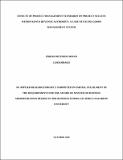| dc.description.abstract | Projects are undertaken with the end goal of getting completed someday. Project
completion is a collective responsibility among the parties involved. The dilemma and
struggle for project completion is a concern in the 21st century. The study intended to find
out possible effect of scope changes on project completion among road construction
projects in Nairobi County with a distinct case of Langata Sub county. The key variables
for the study were; project regulatory compliance changes, project technological changes,
project objective changes, as well as project stakeholders’ changes. These variables were
used to help determine and make informed decisions on the effect of project completion.
The viability of the variables was verified through subjecting them into the theoretical
literature reviews. The theories for determining project completion against the supreme
variables involved: Contingency theory and Theory of Constraints (TOC). The study
engaged descriptive research design and methodology techniques that enhanced data
collection procedures and analysis for effective and reliable findings to the effect of project
completion. The study anticipated to solve the menace of scope changes on project
completion among road construction projects in Nairobi County, Langata Subcounty. Data
was collected through a structured questionnaire in Langata Subcounty. The respondents
provided relevant and useful information based on the research questions that were asked.
It is through such information that informed decisions from the findings were made
regarding the effect of scope changes on project completion among road construction
projects in Nairobi County and recommendations deduced. The recommendations
indicated clearly that project completion is a collective responsibility among the parties
involved. The data gathered was analyzed using the Statistical Package for Social Sciences
(SPSS) version 25. Descriptive statistics such as; frequencies, percentages, mean and
standard deviation were conducted. In addition, correlation statistics, regression analysis
was used to test the relationship between the dependent and independent variables. The
study was therefore viewed as a tool and a guide in determining the effect of scope changes
on project completion among road construction projects across the country. The research
project used a target population of 350 Licensed Road Contractors and Supervising
Engineers. The research project adopted a Nassimas formula that arrived at a sample size
of 78 respondents. From the findings, only 53 response rate was obtained representing
67.9% which was considered to be very good for analysis. Findings were presented in
figure and table form, explained and summarized as well as recorded on a five-point Likert
scale anchored on strongly disagree (1) to strongly agree (5). Recommendations were made
to project managers, licensed road contractors, construction professionals, project
developers, National and County Governments to use findings of the study to realize
project completion. | en_US |




